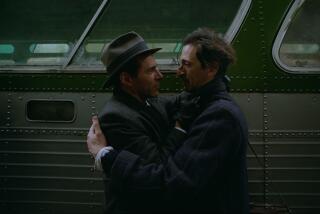HIGH, WIDE, HANDSOME FILM FEST
Judging by the hype, the hustle and the weekly box-office charts, one would think that moviegoers are in the midst of Nirvana Summer, the season when everything came together and the theaters brimmed over with irresistibly fine features.
Right! Like “Jaws 4,” “Nerds 2,” “Superman 4” and “James Bond 14.”
Seems like the same old summer to me.
If Hollywood’s 1987 summer stock hasn’t tweaked the child in you, and if you can’t quite get the movie fix you need from your VCR setup, there is one marvelous alternative in Los Angeles.
The Nuart Theater’s “Festival of ‘Scope,’ ” which began Sunday and runs through Sept. 5, offers not only a feast of good films but is showing them in their original wide-screen format. For most of us, this may be the last chance we’ll ever have to see such pictures as “Silk Stockings,” “West Side Story” and “Gigi” as their creators intended them to be seen.
You can rent all of these movies at your video store, and if your home system is set up for stereo, you can have a pretty good time listening to them. But because those wide images--known by a variety of names with the word scope at the end--won’t fit your nearly square TV screens, you’ll never actually see them. Not all of them.
The video versions have been either panned and scanned (a process of image transfer where the camera appears to be moving toward the focus of each scene) or simply had their sides amputated. If you’ve ever noticed a scene where two people are talking across a room, but all you see is the room, you get the idea.
Gary Meyer, who runs the Landmark Theater chain, said he has always wanted to do a tribute to “scoped” films, and after seeing the public response to a wide-screen series at New York’s Film Forum this spring, he decided to try it at the Nuart in West Los Angeles.
“I wanted to select movies where the film makers really knew how to use the wide-screen format,” Meyer said. “Otto Preminger, Stanley Donen, Elia Kazan, George Cukor, Akira Kurosawa--they were masters at the process.”
All of those directors are represented in the Nuart’s scope festival. In fact, Kurosawa’s 1962 “High and Low” is being shown tonight, along with fellow Japanese director Mikio Naruse’s 1960 “When a Woman Ascends the Stairs.”
Cukor’s “A Star Is Born,” starring Judy Garland and James Mason, is paired Sunday with Rouben Mamoulian’s “Silk Stockings.” You won’t get many chances to see “A Star Is Born” this way, with both its length (the studio cut it to squeeze another showing per day from its 1954 theatrical run) and its width restored.
The oldest film in the series is the 1953 “The Robe,” the first movie made in CinemaScope. The youngest is David Lynch’s “Blue Velvet,” released last year.
Meyer said the biggest problem in putting on a scope festival was discovering which films were actually shot with anamorphic lenses (scoped movies are shot with lenses that “squeeze” wide images onto normal-width film, then projected through lenses that “relax” the images on the screen).
“There are no source books on CinemaScope films,” Meyer said. “Variety used to include the format in its movie reviews, but stopped doing that in the late ‘60s.”
Most of the prints being used in the series are either new or from studio vaults, meaning that you will see the movies not only as the directors intended them to be seen, but in the condition in which they were intended to be seen.
Full “Festival of ‘Scope’ ” schedules are available at the Nuart, but here--from one moviegoer who prefers the old to the new--are some highlights:
Monday--”The King and I” and “Carousel”; Wednesday--”Bonjour Tristesse,” “The River of No Return” (with Robert Mitchum and Marilyn Monroe); Aug. 10--”West Side Story,” “Carmen Jones”; Aug. 12--Elia Kazan’s “East of Eden,” “Wild River”; Aug. 24--”Brigadoon,” “Gigi”; Aug. 26--Robert Altman’s “Nashville,” “Brewster McCloud”; Aug. 30--”Some Came Running,” “The Long Hot Summer”; Sept. 1--Federico Fellini’s “La Dolce Vita” and “Satyricon.”
BANDED SPIELBERG: Nearly a year ago, I had a conversation with cinematographer Alan Daviau during which he said he was almost finished with the panning and scanning for the videocassette version of Steven Spielberg’s “The Color Purple.”
Daviau took exception to the general criticism of pan and scan (see above) and said that in the right hands--the caring hands of the original cinematographer--the process could actually enhance a film for viewing on TV. Daviau even offered to let me sit in on a pan-scan session to see for myself.
But he quickly withdrew the offer, saying that Spielberg didn’t want any publicity on the video preparation, and I forgot the whole thing . . . until last week when I discovered that “The Color Purple” in video stores is the original full-width version.
“The Color Purple,” like Woody Allen’s “Manhattan,” has been “letterboxed,” meaning that the entire wide-screen image appears on your television screen, with black bands at the top and bottom. From a purist’s standpoint, this is better than having fragments of scenes filling the entire screen, but only marginally better. The images are so small, your family may be huddled around the set like your ancestors in the days when 12-inch screens were state of the art.
Why the switch from pan-scan to letterbox?
A spokesman for Spielberg said the decision had nothing to do with the quality of Daviau’s pan-scan efforts. Spielberg simply decided to offer the VCR audience 100% of the film that was seen in theaters.
One of these days, TV manufacturers are going to reshape the screen (they’re working on it now) and the marriage between television and the big screen will finally be consummated.
More to Read
Only good movies
Get the Indie Focus newsletter, Mark Olsen's weekly guide to the world of cinema.
You may occasionally receive promotional content from the Los Angeles Times.










